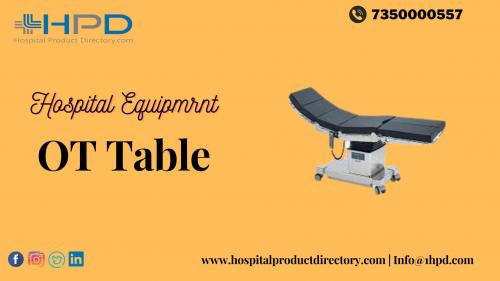The Ultimate Guide to Selecting the Right OT Tables for Your Hospital

1.
Understanding the importance of selecting the right OT tables
Selecting the right operating tables for your hospital is a critical decision that can greatly impact the quality of patient care and surgical outcomes. Operating tables serve as the foundation for surgical procedures, providing a stable and ergonomic platform for surgeons to perform complex operations.
One of the key
reasons why selecting the right operating tables is important is patient
safety. The operating table should be designed by the OT Table Manufacturer to
ensure maximum comfort and support for the patient throughout the procedure. It
should have adjustable features that allow for proper positioning, including
height, tilt, and lateral tilt adjustments. These features not only enhance
patient comfort but also facilitate better access for surgeons and reduce the
risk of complications during surgery.
Another
crucial factor to consider is the versatility of the operating table. Different
surgical procedures require specific positioning and access to various parts of
the body. A versatile operating table can accommodate a wide range of
procedures, from orthopedic surgeries to neurosurgeries. This flexibility
eliminates the need for multiple tables, saving costs and streamlining workflow
in the operating room.
2. Assessing
the specific needs and requirements of your hospital
Before investing in
operating tables for your hospital, it is crucial to assess the specific needs
and requirements of your medical facility. Each hospital is unique and may have
different specialties, surgical procedures, and patient demographics. Taking
the time to thoroughly evaluate these factors will ensure that you select the
right operating tables that align with your hospital's goals and provide
optimal patient care.
Start by
considering the types of surgeries performed in your hospital. Are they
primarily orthopedic, cardiovascular, neurosurgical, or a combination of different
specialties? Each surgical specialty may require specific features and
functionalities in an operating table to accommodate the unique needs of the
procedures. For example, orthopedic surgeries often require tables with
enhanced imaging capabilities and adjustable leg sections to facilitate proper
positioning.
Next, consider
the size and weight capacity requirements of your patient population. Operating
tables should be able to support a wide range of patient sizes, from pediatric
to bariatric, ensuring patient comfort and safety during procedures. Assessing
the weight capacity of the tables is crucial to accommodate patients with
varying body masses, as well as any additional equipment that may be utilized
during surgeries.
Another
crucial aspect to consider is the ease of use and maneuverability of the
operating tables. Surgeons and operating room staff require tables that can be
easily adjusted and positioned to provide optimal access to the surgical site.
Look for tables that are available with OT Table
Suppliers with intuitive control systems, smooth
movements, and ergonomic design features that promote ease of use and enhance
surgical efficiency.
3.
Identifying the different types of operating tables available
When it comes to
selecting the right operating tables for your hospital, it's crucial to have a
clear understanding of the different types available in the market with OT Table
Dealers. Each type serves a specific purpose and offers unique
features that cater to various surgical procedures. By identifying and
evaluating these options, you can make an informed decision that meets the
specific needs of your hospital.
1. General
Operating Tables:
These tables
are versatile and can be used for a wide range of surgical procedures. They
typically come with adjustable height, backrest, and leg sections, allowing
surgeons to position patients in the most comfortable and optimal positions.
General operating tables often have a weight capacity suitable for most
patients and offer stability and flexibility.
2. Specialty
Operating Tables:
Specialty
tables are designed to cater to specific surgical specialties or procedures.
They are equipped with specialized features to ensure precise positioning and
accessibility. For example, orthopedic tables may have attachments for traction
or extension, while neurosurgery tables may offer head positioning and imaging
capabilities.
3. Imaging
Tables:
Imaging tables
are specifically designed to accommodate imaging equipment such as C-arms or X-ray machines.
They provide a platform for performing procedures that require real-time
imaging guidance. These tables are often equipped with radiolucent sections,
allowing for unobstructed imaging without compromising patient positioning.
By identifying the different types of operating tables available, you can narrow down your options and select the ones that align with your surgical specialties, patient demographics, and overall hospital requirements. Remember to consider factors such as durability, ease of use, maintenance, and compatibility with existing equipment when making your final decision.
4. Considering the key features and functionalities of operating tables
When it comes to
selecting the right operating tables for your hospital, it is crucial to
carefully consider the key features and functionalities that will meet the
specific needs and requirements of your surgical procedures.
One of the
primary factors to consider is the table's adjustability. The ability to easily
adjust the height, tilt, and lateral positioning of the table is essential for
accommodating different surgical procedures and ensuring the comfort and safety
of both patients and medical staff. Additionally, look for tables with features
such as a Trendelenburg position, reverse Trendelenburg position, and lateral
tilt capabilities, as these can greatly enhance the versatility and flexibility
of the table during surgeries.
Another
important aspect to consider is the weight capacity of the operating table. Different
surgeries may require varying levels of weight support, so it is vital to
select a table that can handle the anticipated maximum weight load. This will
help prevent any potential accidents or equipment failures during procedures.
Furthermore,
the table's stability and durability should not be overlooked. Surgical
procedures can be intense and demanding, so it is crucial to choose a table
that is built with robust materials and construction. Look for features such as
sturdy base frames, reinforced supports, and high-quality upholstery materials
that can withstand the rigors of daily use and maintain patient safety.
Post Your Ad Here
Comments